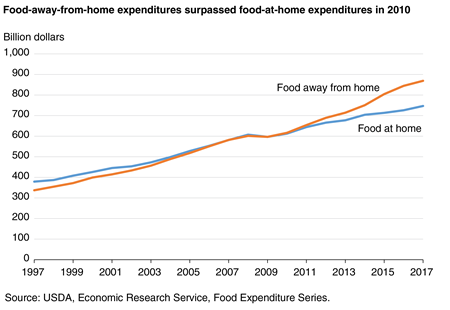Op-Ed: Food Supply Chains Under Strain, Tips to Cope
Hello, my fellow American Patriots. I wanted to share with you an observation I have noticed while on my social media platforms of late. The conversations and commentary have been very focused on the food supply chain, and more specifically, fears of dire food shortages. Although there have been particular companies and product lines initially negatively impacted in this crisis, we must all understand these issues relate to getting food products to market, and not a lack of capability to produce food. Fear not we are not going to starve in the United States.
The growing anxiety I pick up on has much to do with a lack of understanding about our food supply chain in general. Going back to where this COVID-19 crisis began helps understand the recent shortages on shelves of some products. Consider that food consumption in America breaks down to a 55/45 proposition. Normally 55% of all food consumed by Americans is “outside the home” (not prepared in the home). This leaves 45% of food being consumed and prepared “inside the home” (grocery obtained).
There are two separate food supply chains, commercial and residential. This separation explains the issues early on that presented in this crisis having some shelves in grocery stores empty.
Restaurants and “outside the home” vendors do not primarily rely on grocery purchases to supply their food. As a result of Coronavirus mitigation efforts, the food “outside the home” sector purchasing product has dropped by 75%. The converse of this has been a significant strain on the grocery retail market to provide all those who are now “inside the home” shopping, who normally did not do so to this degree.
There are many steps in food supply chains, so here is a brief rudimentary review:
Most Americans are unaware that there are only a total of 175,642 commercial facilities involved in the supply chain across the country. Farmers produce products, and some go directly into bulk storage, which always exists, such as frozen/fresh, dairy, meat, fruit, grains, and vegetables. The retail consumer supply chain for manufactured and processed foods has always stocked a harvest ahead and is designed to offset weather impacts. This bulk storage makes up most of the grocery store food supply chain for the manufactures that make products under brand names and distribute directly to grocery stores.
The commercial supply chain (restaurants, hotels, schools) is separate and utilizes primarily local and fresh food vendors with short shelf life and high turn over rate. It makes perfect sense that since so many Americans have been social distancing, despite, take out orders, that the “outside the home” demand for food products has plummeted. Social distancing and lockdowns have more Americans utilizing retail grocery chains than before the pandemic, which has resulted in them operating beyond food supply rates by as much as 40%.
Now one might ask why not just switch over supply chains and send the excess of commercial to retail market? This is a complicated subject, but the government’s regulatory compliance structure and food subsidy programs are not designed for flexibility and are embedded with perverse incentives that hamper easy integration. President Trump has invoked the Defense Protection Act to address food supply chain issues.
Agricultural Secretary Sonny Purdue, last week, announced a 3 billion dollar plan to distribute food to American families called the “Farm to Family Food Box Program,“ which will pay farmers to box up produce, dairy, and meat product that had been slated for disposal due to supply chain disruptions. Pandemic aside, many farmers plant 300 acres, of perhaps broccoli, that any particular season does not sell well, so they plow it under. Purdue should keep this new program in play after the crisis to address that. Purdue discusses the difference between a shortage of food versus a disruption in the way food gets to the consumer. Purdue states:
“When you have the shutdown very suddenly of institutional food settings such as restaurants, schools, colleges, and others, then that causes a misalignment in supply,” Perdue tells Morning Edition. “And we’ve had to scramble in order to try to readjust that, and this food box program is one of those things which we’ve tried to do.”
In the same May 15th interview, Purdue was asked:
“Do you anticipate widespread food shortages in the coming months?” He replied, “No, I don’t, Steve. We track daily our plant openings. One of the challenges we had in protein – meat, poultry, beef, pork – had been the closure of some of our processing plants there. And we’ve had infections in those plants that caused some temporary closures. Essentially all those plants are back open. We’ve turned the corner, and while some retailers are suggesting they may not have the degree of variety that they once had, we expect that to be cured very quickly. I do expect us to be back up to 85-90% production, in probably a very few days or weeks.”
Patriots, Tyson and Smithfield, had plant closures related to infection breakouts among staff. I had chosen to boycott Smithfield a long time ago once I found out they were Chinese owned facilities. This pandemic has unearthed many uncomfortable truths, but the United States consumer’s dependency on Chinese manufacturing for essentials, like food and medicines, provides an opportunity to change going forward. President Trump has indicated a radical change involving the manufacturing of essentials back on US soil.
We will all get through this pandemic and the temporary slowing of the food supply chain and increases in the cost of food. But perhaps this experience can remind us what our parents and grandparents understood so well. Self-reliance, planning, and a little ingenuity protect one’s family in the event of an unsuspected tragedy, financial downturns, and yes, even pandemics. Preparation provides peace of mind and a sense of control in uncertain times.
If you are concerned about the rising cost and availability of meat, consider going in with a friend or family member purchasing and dividing a whole half of a side of cow or pig. Mennonites and other local farmers often sell half side of beef at fair rates. A good additional freezer is an excellent investment that saves money in the long run. Learning how to can vegetables/fruit and even butter can be both useful and fun, and teaching the youth to do so can be a life skill.
Why worry yourself into a tissy about a fear of food scarcity when you can plant a garden to provide you sustenance. One doesn’t need acres of land to provide a harvest to feed a family, only a small plot of land or container gardens. If you are infirmed or disabled, there are many young people who, for a small fee, will put in your garden and assist with any maintenance you cannot do yourself. Some may even be open to bartering harvest (food) for labor costs. Please see examples to help you.
The MIGardner on Youtube is very informative:
Simplify Gardening is another:
I recall back in the sixties and seventies when I was raising my family when finances got tight – we would go visit farms in our area. The farmers would have roped off sections where you could physically pick your food, and they would sell it to you in a bushel. Today, local farmers’ markets are also available. Local Dairies, honey farms, and orchards are also great ways to get the freshest and most nutritious ingredients to feed your family.
The good news is, America and its farmers are the most abundant and variety-packed resources for food on the planet. The silver lining in this pandemic is maybe Americans will go back to basic common-sense practices and lessen their dependency on government and corporate entities for so much of essential daily life. Generations for centuries seemed capable of doing so, and Patriots are too!





